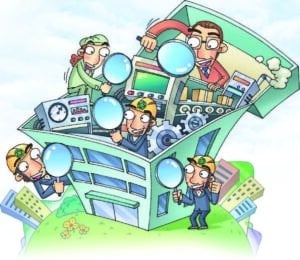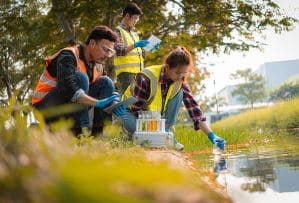Australia’s biodiversity and public health are priorities for protection. Discover how HERA by iEnvironmental Australia becomes your shield against environmental and health risks, blending science with safety to guard what matters most.
What are Human and Ecological Risk Assessments?
HERA evaluates potential impacts of environmental contaminants on human health and ecosystems. It’s a scientific process determining the likelihood of adverse effects under specific exposure scenarios. Human risk assessment focuses on potential health risks to people, while ecological risk assessment evaluates risks to wildlife, plants, and entire ecosystems. These assessments are critical in a variety of settings, from industrial developments to natural resource management. Additional key points include:
-
- Integration of Multidisciplinary Approaches: HERA combines expertise from toxicology, environmental science, epidemiology, and ecology.
- Assessment of Chemical and Biological Hazards: It includes evaluating the impact of chemical substances and biological agents.
- Use of Predictive Models: These assessments often utilize predictive modeling to estimate potential impacts under various scenarios.
- Consideration of Vulnerable Populations: Special attention is given to sensitive or vulnerable groups like children, the elderly, or endangered species.
- Long-term and Short-term Risk Evaluation: HERA considers both immediate and long-term consequences of exposure.
- Cumulative Impact Analysis: It also assesses the combined effects of multiple stressors on human health and the environment.
- Adaptability to Various Environments: HERA methodologies are adaptable to a range of environments, from urban areas to natural habitats.
Why are Human and Ecological Risk Assessments Important?
These assessments are vital for informed decision-making in environmental management. The significance of HERA cannot be overstated, as they play a pivotal role in protecting public health and preserving the environment. Further reasons for their importance include:
- Informing Policy and Regulation: HERA findings are crucial in shaping environmental policies and regulations.
- Guiding Remediation and Mitigation Strategies: They help in devising strategies to remediate and mitigate environmental hazards.
- Enhancing Public Awareness: These assessments can increase public understanding and awareness of environmental risks.
- Supporting Sustainable Development: They are essential for balancing development needs with environmental conservation.
- Aiding in Emergency Response Planning: HERA is vital for preparing and responding to environmental emergencies.
- Promoting Environmental Justice: They play a role in ensuring that environmental burdens are not disproportionately borne by disadvantaged communities.
- Encouraging Responsible Corporate Practices: Businesses use HERA to align their operations with environmental sustainability standards.
They help identify and mitigate potential risks posed by contaminants, ensuring the safety of human populations and the preservation of ecological systems. In Australia, with its rich biodiversity and dense human settlements, HERA is instrumental in balancing development with environmental conservation.
How are Human and Ecological Risk Assessments Conducted?
HERA involves several steps:
- Problem Formulation: Identifying the environmental issue and potential receptors.
- Exposure Assessment: Estimating the concentration and duration of exposure to contaminants.
- Effects Assessment: Determining the relationship between exposure and adverse effects.
- Risk Characterization: Integrating exposure and effects data to assess risk.
- Stakeholder Engagement: Involving stakeholders, including local communities and regulatory bodies, in the assessment process.
- Uncertainty Analysis: Identifying and addressing uncertainties in data and methodologies.
- Use of Geographical Information Systems (GIS): Utilizing GIS for spatial analysis of environmental risks.
- Peer Review and Validation: Ensuring the scientific rigor of the assessment through peer review and validation processes.
- Continuous Updating: Updating assessments as new information or technologies become available.
What are the Key Components of Human and Ecological Risk Assessments?
Human and Ecological Risk Assessments (HERA) consist of several fundamental components that ensure their effectiveness and reliability. Key components include:
- Hazard Identification: Identifying potential contaminants and their sources.
- Dose-Response Assessment: Understanding the relationship between exposure levels and the severity of effects.
- Exposure Analysis: Quantifying the amount and duration of exposure.
- Risk Calculation: Estimating the likelihood of adverse health or ecological outcomes.
- Risk Communication: Effectively communicating risk findings to stakeholders, including non-scientific audiences.
- Regulatory Compliance Checks: Ensuring that assessments align with local, national, and international environmental regulations.
- Socio-Economic Considerations: Integrating socio-economic factors into risk assessments to understand broader impacts.
- Temporal and Spatial Dynamics: Considering how risks may change over time and across different geographical areas.
- Ecosystem Services Evaluation: Assessing how risks impact the services ecosystems provide, like water purification and pollination.
- Scenario Development: Creating hypothetical scenarios to understand potential future risks.
- Sensitivity Analysis: Examining how changes in assumptions or data affect the risk assessment outcomes.
What are the Applications of Human and Ecological Risk Assessments?
The applications of HERA are diverse and play a critical role in various fields. HERA is applied in various contexts, including:
- Climate Change Adaptation: Assessing risks associated with climate change to inform adaptation strategies.
- Biodiversity Conservation: Guiding efforts to protect and conserve biodiversity.
Industrial Site Management: Identifying and managing risks in industrial settings, including manufacturing and mining.
- Urban Planning: Incorporating risk assessments in the development and planning of urban areas.
- Agricultural Practices: Guiding safe and sustainable agricultural practices to minimize environmental impact.
- Public Health Initiatives: Informing public health policies and initiatives.
- Natural Disaster Preparedness: Assessing environmental risks associated with natural disasters for better preparedness and response.
These applications help manage environmental risks effectively, ensuring sustainable development practices.
Protecting Human Health and the Environment with Human and Ecological Risk Assessments
In our commitment to safeguarding human health and the environment, HERA plays a foundational role. Further elaborating on this commitment:
- Continuous Improvement: Regularly updating methodologies and practices to reflect the latest scientific developments.
- Collaborative Approach: Engaging with a wide range of stakeholders, including government agencies, community groups, and industry partners.
- Emphasis on Prevention: Focusing on preemptive measures to mitigate risks before they become critical issues.
- Resource Optimization: Utilizing HERA to ensure efficient and effective use of resources in environmental protection efforts.
- Education and Training: Providing education and training to ensure all involved parties understand and can effectively contribute to risk assessments.
- Transparency and Accountability: Maintaining transparency in our processes and being accountable for our assessments and recommendations.
- Advocacy for Environmental Stewardship: Actively advocating for responsible environmental practices based on HERA findings.
Our Commitment to Excellence in Human and Ecological Risk Assessments at iEnvi
At iEnvironmental Australia (iEnvi), we dedicate ourselves to the meticulous application of Human and Ecological Risk Assessments (HERA) for the advancement and protection of communities and ecosystems. Our method is all-encompassing, blending cutting-edge scientific methodologies with the most current regulatory frameworks. Our team, driven by passion and expertise, ensures that each assessment is comprehensive, accurate, and finely tuned to meet the specific needs of our clients while upholding the highest standards of environmental stewardship.
Unwavering Dedication to Detail and Accuracy in HERA
HERA serves as the bedrock of our mission to bring forward-thinking and effective solutions to environmental challenges. By conducting these detailed assessments, we significantly contribute to the preservation of Australia’s unique natural environment and the health of its inhabitants.
- Scientific Rigor and Innovation: We employ advanced scientific techniques and innovative approaches to ensure our risk assessments are at the forefront of environmental science.
- Regulatory Alignment: Our assessments are not only scientifically robust but also meticulously aligned with the latest environmental regulations, ensuring compliance and reliability.
- Client-Centric Approach: Understanding that each client has unique needs, we tailor our assessments to provide solutions that are both practical and effective, ensuring their commercial and regulatory interests are well-protected.
Protecting Australia’s Environment and Public Health
Our commitment to HERA is not just a professional choice but a reflection of our dedication to safeguarding Australia’s environment and public health.
- Ecosystem Protection: By accurately assessing ecological risks, we contribute to the protection and conservation of Australia’s rich biodiversity.
- Public Health Safeguarding: Our human health risk assessments are designed to protect communities from potential environmental hazards, ensuring a safer living environment.
- Sustainable Development: Our services aid in achieving a balance between developmental needs and environmental preservation, promoting sustainable growth and practices.
Engage with Us for a Healthier, More Sustainable Future
Your engagement and feedback are invaluable to us. We encourage you to share your thoughts, concerns, and inquiries. Reach out to us for comprehensive HERA services. Together, we can work towards a healthier, more sustainable future for Australia and its diverse ecosystems.
iEnvi’s commitment to excellence in HERA is unwavering. We are dedicated to providing our clients with the highest level of service, informed by our deep understanding of ecological risk assessment and human health impacts. Our goal is not just to meet but exceed expectations in environmental consulting, ensuring that every project contributes positively to our collective future.



 Industrial Site Management: Identifying and managing risks in industrial settings, including manufacturing and mining.
Industrial Site Management: Identifying and managing risks in industrial settings, including manufacturing and mining.